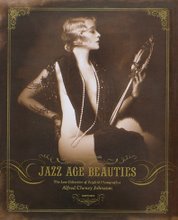I gradually found that I was at an extreme disadvantage in attempting to negotiate a book deal with ABRAMS. If I had had an agent, the process of finding out if they were serious about publishing a book on Alfred Cheney Johnston would have been swift because an agent would have only given them a limited time to make up their minds. I would have found out fairly quickly if I had a deal. But on my own, I was at the mercy of their time schedule. Christoper was “their“ messenger, and although he was adamant about publishing the book right away, it became obvious very soon, that someone else was pulling the strings.
I hadn’t put all of my eggs in one basket though…I had also made contact with McFarland & Company, Inc. located in Jefferson, North Carolina. They expressed interest in a book on Johnston almost immediately. Had I known how much of my time ABRAMS was going to consume, I think I would have considered McFarland more seriously. The main issue with McFarland, was that the photography reproductions in their books wasn’t anywhere close to the fine art quality of ABRAMS. McFarland published fine books about silent film stars by very reputable authors such as Eve Golden, but the focus wasn‘t on the print quality. Photographs were treated as documents supporting the text. I knew that Johnston’s magnificent images had to be treated like works of art and that they had to be printed by the best printer I could find- printed on the finest quality paper as duotones or full color reproductions.
A committee of people was going to make the decision about the Johnston book- Christopher would be making a presentation to them on Tuesday. Tuesday’s in the publishing world, at least at ABRAMS, was the day editors and Marketing and PR people all got together to make presentations or check the progress of projects in development. After his first meeting with the committee, Christopher told me that we needed to research certain information and then he would get back to the committee in 2 weeks or so and make another presentation.
The problem is that this began to drag on as a pattern over many months. Christopher reiterated that ABRAMS was going to publish the book, while at the same time, he was asking me to provide him with more information and details….about my research, ACJ collectors, image banks, possible writers to co-write my essay, etc….all with no contract. Every few weeks or so, he would re-present the project to the committee. I naively continued on in this manner believing it would all be worth it to see the beautiful coffee table book on Alfred Cheney Johnston that I was envisioning.
I learned later that the world of book publishing of the 21st century had gotten much smaller and less friendly toward large volume art books than in the Paul Gottlieb glory years of the 1980’s. Many of the smaller publishers had closed or been acquired by larger ones who wanted a sure thing- guaranteed profits. To complicate the process, in the case of photography books publishers wanted the whole “package” to be ready for them. By “package” I mean, they wanted the author to give them the entire book, ready to go- with quality essays written by renowned persons from renowned institutions and a collection of images ready for press.
During the entire ABRAMS experience, I continued my ACJ research and worked hard to make contact with more resource people. Nils Hanson, at the Ziegfeld Club of New York was absolutely my best source for contacts. During the ABRAMS debacle (as I now view it), Nils suggested I contact his friend Richard Ziegfeld…He was a distant cousin of Flo Ziegfeld, and with his wife Paulette, had worked with Paul Gottlieb on a coffee table book in the 1980’s called “The Ziegfeld Touch.” I gave him a call….
Thursday, December 15, 2005
Subscribe to:
Posts (Atom)
